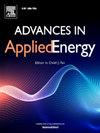Physics-informed modularized neural network for advanced building control by deep reinforcement learning
IF 13.8
Q1 ENERGY & FUELS
引用次数: 0
Abstract
Physics-informed machine learning (PIML) provides a promising solution for building energy modeling and can be used as a virtual environment to enable reinforcement learning (RL) agents to interact and learn. However, how to integrate physics priors efficiently, evaluate the effectiveness of physics constraints, balance model accuracy and physics consistency, and enable real-world implementation remain open challenges. To address these gaps, this study introduces a Physics-Informed Modularized Neural Network (PI-ModNN), which integrates physics priors through a physics-informed model structure, loss functions, and hard constraints. A new evaluation matrix called “temperature response violation” is developed to quantify the physical consistency of data-driven building dynamic models under varying control inputs and training data sizes. Additionally, a physics prior evaluation framework based on “rule importance” is proposed to quantify the contribution of each individual physical priors, offering guidance on selecting appropriate PIML techniques. The results indicate that incorporating physical priors does not always improve model performance; inappropriate physical priors could decrease model accuracy and consistency. However, hard constraints effectively enforce model consistency. Furthermore, we present a general workflow for developing control-oriented PIML models and integrating them with deep reinforcement learning (DRL). Following this framework, a case study of implementation DRL in an office space for three months demonstrates potential energy savings of 31.4%. Finally, we provide a general guideline for integrating data-driven models with advanced building control through a four-step evaluation framework, paving the way for reliable and scalable implementation of advanced building controls.
基于深度强化学习的先进建筑控制的物理信息模块化神经网络
物理信息机器学习(PIML)为建筑能源建模提供了一个有前途的解决方案,可以用作虚拟环境,使强化学习(RL)代理能够交互和学习。然而,如何有效地整合物理先验,评估物理约束的有效性,平衡模型准确性和物理一致性,并使现实世界的实施仍然是一个开放的挑战。为了解决这些问题,本研究引入了一种物理信息模块化神经网络(PI-ModNN),该网络通过物理信息模型结构、损失函数和硬约束集成了物理先验。为了量化不同控制输入和训练数据大小下数据驱动的建筑动态模型的物理一致性,建立了一个新的评价矩阵“温度响应违逆”。此外,提出了一个基于“规则重要性”的物理先验评价框架,以量化每个物理先验的贡献,为选择合适的PIML技术提供指导。结果表明,加入物理先验并不一定能提高模型的性能;不适当的物理先验会降低模型的准确性和一致性。然而,硬约束有效地加强了模型的一致性。此外,我们提出了开发面向控制的PIML模型并将其与深度强化学习(DRL)集成的一般工作流程。在此框架下,一个在办公空间实施DRL三个月的案例研究表明,潜在的节能效果为31.4%。最后,我们通过四步评估框架提供了将数据驱动模型与先进建筑控制集成的一般指南,为可靠和可扩展的先进建筑控制实施铺平了道路。
本文章由计算机程序翻译,如有差异,请以英文原文为准。
求助全文
约1分钟内获得全文
求助全文

 求助内容:
求助内容: 应助结果提醒方式:
应助结果提醒方式:


